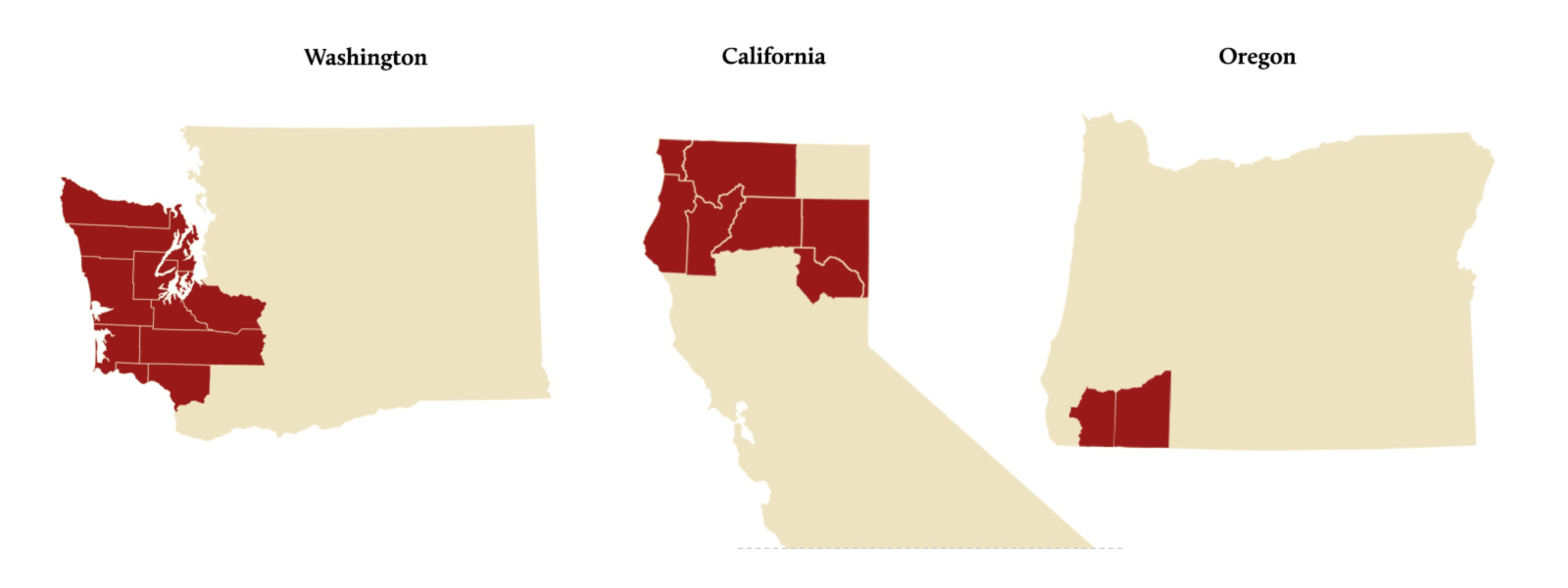Our Giving
The Ben B. Cheney Foundation makes grants in the communities where Mr. Cheney’s lumber company operated.
Within those communities, the Foundation will respond to a wide variety of requests. The Foundation’s main goal is to support efforts that help to improve the quality of life in those communities.
The following information will help you evaluate how the Foundation might respond to your request.
Key elements listed below include;
- Geography
- Type of Grant
- Program Areas
- Eligibility

Geography
Washington
Pierce County is the Foundation’s primary giving location. We also consider grant requests from communities in southwest Washington, the Olympic Peninsula (Thurston, Mason, Jefferson, and Clallam counties), and Kitsap County.
In a typical year, we average the following grant amounts;
- Pierce County; 20 to 30 grants / $1.1 to $1.4 million
- Olympic Peninsula; 2 to 5 grants / $60,000 to $80,000
- Southwest WA; 5 to 8 grants / $100,000 to $130,000
Oregon
The Foundation’s primary giving location is Medford/Jackson County, with a few grants in Grants Pass/Josephine County.
In a typical year, we average the following grant amounts;
- Jackson County; 6 to 9 grants / $175,000 to $200,000
- Josephine County; 0 to 2 grants / $0 to $25,000
California
The Foundation’s giving in Northern California includes the following counties; Del Norte, Siskiyou, Humbolt, Trinity, Shasta, Lassen, Plumas.
In a typical year, we average the following grant amounts;
- Northern California; 2 to 5 grants / $70,000 to $80,000
Type of Grant
The Foundation is open to a wide variety of programs serving the communities where we give. We prefer to focus on project grants rather than ongoing operating support.
A project has three distinguishing features:
- A specific time period with a beginning and an end,
- Specific accomplishments for the project, and
- A specific budget that outlines both what resources the organization needs to achieve the stated accomplishments and where the organization plans to obtain those resources.
We prefer to fund projects that:
- Invest in equipment or facilities that will have a long-lasting impact on community needs.
- Demonstrate local community support with a base of local community funding.
- Develop new and innovative approaches to community problems.
- Expand existing programs to serve more people and/or areas.
Project grants are generally given on a one-time basis. The Foundation will evaluate an organization’s plans for sustaining the impact of project grants, especially those for program expansion.
That evaluation will include these questions:
- Are there identified sources of support capable of sustaining the program?
- Is the organization committed to a strategy to gain those sources of support?
- Does the project plan include activities towards gaining that sustainability?
While the Foundation understands that fundraising is a part of most budgets, we feel that this approach allows us to respond to needs that go above and beyond the annual operating budget. As a result, projects for one-time capital or equipment needs often gain priority.
Program Areas
The Foundation organizes its grant making into eight categories. The Foundation does not budget to categories in advance and grant seekers are not required to apply by category.
Charity – Programs providing for basic needs such as food, shelter, and clothing.
Civic – Programs improving the quality of life in a community, such as museums and recreation facilities.
Culture – Programs encompassing the arts.
Education – Programs supporting capital projects and scholarships, primarily for six pre-selected colleges and universities with a record of service to Pierce County.
Elderly – Programs serving the social, health, recreational, and other needs of older people.
Health – Programs related to providing health care.
Social Services – Programs serving people with disabilities or other special needs.
Youth – Programs helping young people to gain the skills needed to become responsible and productive adults.
Eligibility
The Foundation generally limits it grants to public charities. That means the Internal Revenue Service has recognized an organization under 501 (c) (3) and also found that it is a public charity under 509 (a) (1) or (2).
Organizations that received their public charity status as supporting organizations under 509 (a) (3) should call our office to discuss eligibility.
Units of government may be eligible depending upon the nature of the request.
New programs or associations that operate under the auspices of a fiscal sponsor must have that sponsor apply on their behalf.
The Foundation generally does not make grants to:
- Support general operating budgets or annual campaigns
- Sponsorships for fundraising events
- Projects which are supplanting tax funded expenditures
- Religious organizations for sectarian purposes
- Basic research
- Endowment funds
- Individuals
- Produce books, films or videos
- Conferences, seminars, or attendance at same
- Individual students or student groups raising money for school-related trips
Our hope is that your organization can make the strongest case to any funder you choose to approach. However, funding decisions involve timing, amounts, and most important, what the funder hopes to accomplish in its work.
While your project may be aligned with a funder’s work, the funder may also have many other opportunities for funding that score better with regards to mission, timing, and grant budgets.

